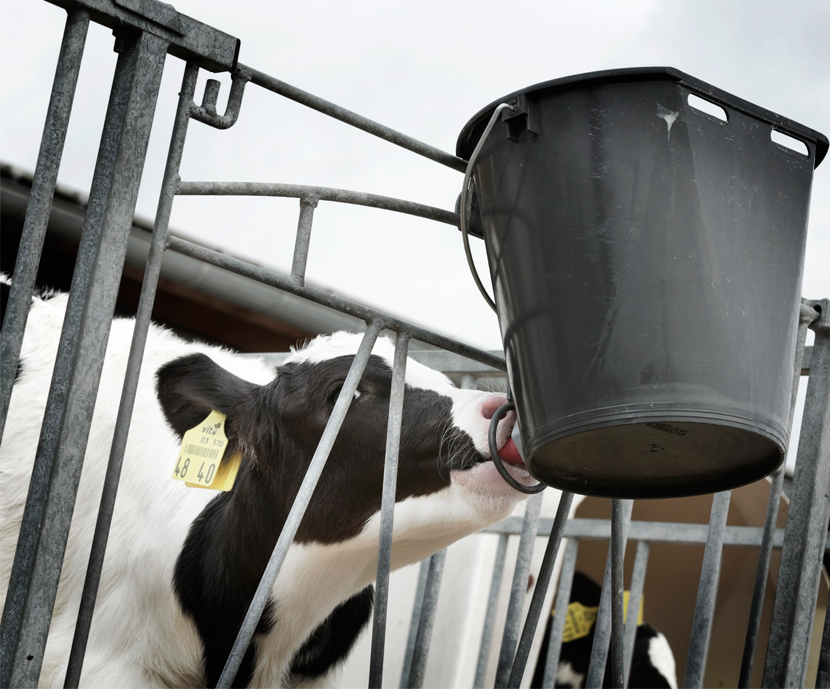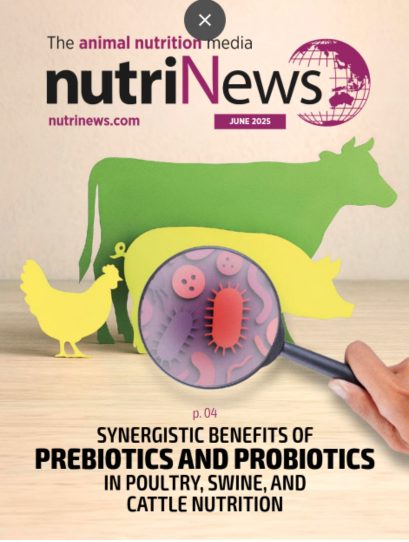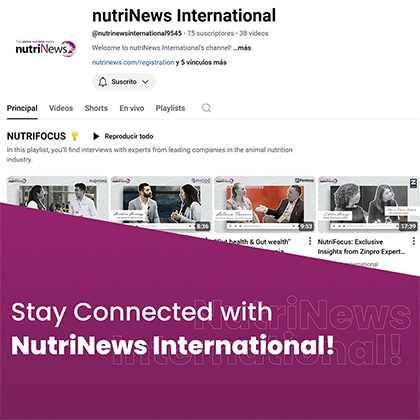Calf Nutrition in the Heat – How to Turn a Tough Start into a Long Productive Life
We all know how crucial the early stage in a dairy calf’s life is for its future success as a dairy cow. In Cyprus, where I live, I experience on an annual basis, just how important that care is, when calves are born in the hottest month of the year in a hot climate.
Mastering that challenge is what you might call “calf rearing for the advanced”. I would like to share some calf nutrition and management practices that play a key role on dairy farms in Cyprus and other hot environments.
Why are dairy calves born in August in Cyprus?
August is the hottest month in Cyprus with temperatures averaging around 32°C. Adding the humidity coming from the sea, cows and people are continuously at risk to suffer from heat stress, much more than in other European countries. You could say it is a highly uncomfortable environment for a calf to be born into. Plus, with the mothers most likely experiencing some level of heat stress in the late stages of pregnancy, calves will already be disadvantaged in their start, before they were even born.
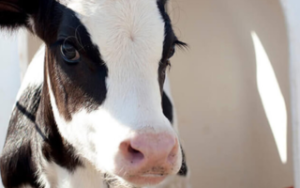
Still, it is common practice for dairy herds in Cyprus to manage the calving cycle of their cows for a batched calving season in late August. The main reason being that is it is difficult to get cows into calf during the hot summer months.
Heat stress reduces the duration and intensity of estrus, resulting in silent heat or weak estrus expression, making it difficult to detect cows on heat. On top of that it can depress follicular development leading to poor quality oocytes in cows, which altogether reduces the probability of successful inseminations.
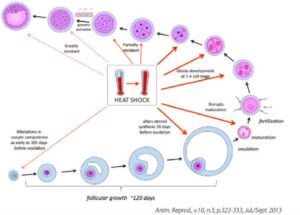
As a result, conception rates in dairy cows are generally low between July and September in Cyprus. Additionally, carry-over effects from the summer months can result in cystic ovaries in October, such that most dairy cows are generally not inseminated until November.
An unfair disadvantage
Several studies found calves born in the summer had significantly lower average daily gains than 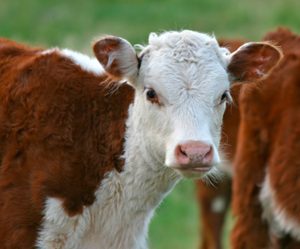 calves born at other times of the year, independent of housing types. Increasingly high summer temperatures and high humidity can cause heat stress in calves. This leads to reduced feed intake and increased maintenance energy needs coupled with lowered immunity, which are all factors contributing to poor growth and higher susceptibility to disease.
calves born at other times of the year, independent of housing types. Increasingly high summer temperatures and high humidity can cause heat stress in calves. This leads to reduced feed intake and increased maintenance energy needs coupled with lowered immunity, which are all factors contributing to poor growth and higher susceptibility to disease.
The other disadvantage dairy calves in Cyprus are very likely to experience, occurs before they are even born. Their mothers are at high risk to experience heat stress in late pregnancy. Research has shown decreased birth weights in calves born to dairy cows experiencing heat stress in the last 8 weeks of pregnancy.
Furthermore, studies found that heat stress in the dam did not only compromise foetal growth but also immune function of offspring from birth to weaning. Additional negative impacts of dams experiencing high temperatures during late pregnancy are drops in the quality and quantity of colostrum.
![]() Others have reported that the negative prenatal heat stress effects could persist in the future stage of calves. Calves that experienced maternal heat stress produced less milk in the first lactation than calves with mothers that were kept in a cool environment.
Others have reported that the negative prenatal heat stress effects could persist in the future stage of calves. Calves that experienced maternal heat stress produced less milk in the first lactation than calves with mothers that were kept in a cool environment.
Why it is important to compensate for a tough start
The positive relationship between pre-weaning daily gain in dairy calves and their future lifetime productivity as dairy cows is scientifically proven. Hence why the impact of early life nutrition in calves and its opportunity to improve long-term cow health, performance and welfare is a hot topic.
Dairy calves born in Cyprus are really dealt a tough hand at the beginning of their life. This requires farmers to pay extra attention to detail when caring for their calves, if they want to see them grow into high producing resilient dairy cows.
Nutritional support for calves to cope with heat
Mitigating heat stress in calves will support their growth and development and lays the foundation for a productive and healthy dairy herd.
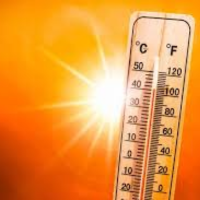
Calves can double the amount of water intake to help them handle heat stress and stay hydrated. Research from the Iowa State University in the US has shown that the importance of offering water from the start of a calf’s life has been underestimated. While on farms it was much more common practice to offer free-choice water after calves were 17 days of age, this research suggests that providing supplemental drinking water starting at birth can benefit growth performance in calves.
- Furthermore, the researchers observed improved nutrient digestibility and improved rumen function leading to increased feed efficiency in calves being offered water starting on day 1 of life. It is good practice to introduce each calf to water to ensure they understand water is available.
On top of that adding electrolytes to the drinking water has been shown to be beneficial particularly during times where calves are at risk of heat stress. Electrolytes can help restore imbalances associated with heat stress and dehydration and prevent calf scours.
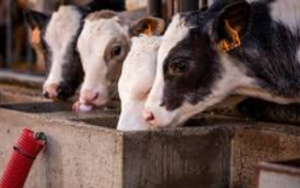
In high temperatures calves will burn more energy as they try to lower their body temperature, which leaves less energy available for growth. Coupled with a decrease in feed intake in response to environmental heat, calves will grow much slower during the heat.
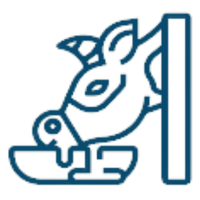
However, studies have shown that heat stress is more likely to affect starter intake than milk replacer intake. Increased feeding rate of milk replacer (0.66 kg vs. 0.44 kg dry matter/d, 21% crude protein, 21% fat) increased average daily gain and hip width in calves raised in summer months, confirming that increased feeding rates of milk replacer can help to overcome some of the average daily weight gain lost during heat stress in young dairy calves.
- Canadian researchers led by Steele promote feeding higher levels of milk in the first 4 weeks of life to optimize growth pre-weaning, regardless of environmental temperature.
First class calf management practices
This article only focuses on some of the management practices that can affect the impact of nutrition in calves and are of increased importance in a hot environment.
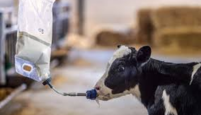
Since the quality of colostrum is of magnified importance in calves born into a hot environment, storage and handling of colostrum requires extra care to maximize quality. Best practice is to store the colostrum in flat bags and not in plastic bottles in the freezer.
- It also pays more to monitor the quality of the colostrum continuously very closely for IgG levels to ensure calves are receiving adequate passive transfer.
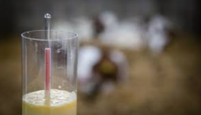
As explained above colostrum quality often declines during the summer months. On top of that there is greater risk for bacteria and disease organisms to multiply, so colostrum should also be sampled routinely for coliforms to reduce the risk of feeding dirty or contaminated colostrum to calves.
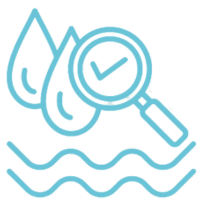 The drinking water hygiene plays a crucial role for the health of the calf at the best of times. However, hygiene management for the buckets and water provided needs to be extra strict in a hot environment, where pathogens will multiply more quickly. Empty and refill water buckets at least twice a day to keep water fresh.
The drinking water hygiene plays a crucial role for the health of the calf at the best of times. However, hygiene management for the buckets and water provided needs to be extra strict in a hot environment, where pathogens will multiply more quickly. Empty and refill water buckets at least twice a day to keep water fresh.
- One more thing to have a very close eye on, is making sure to keep the calf starter and grain fresh. During the hot months, flies, mould and heat spoilage are a greater problem. On the other hand, calves also eat less when they are hot. So, it is a challenge to ensure that the grain supply is fresh at all times and needs to be checked more frequently and discard uneaten portions.
- Offering smaller amounts of fresh calf starter more often will decrease spoilage and help intakes. Supplementing the calf starter with a fly control additive can help to reduce the fly population and spread of disease.
Advanced nutritional strategies for dairy calves
What you feed a calf in the first 60 days of its life can determine its performance as an adult cow and it is not just the quantity that is important, it is also the quality.
A proactive approach to establishing a healthy gut in calves can minimize financial losses in the form of calf treatments and morbidities, but also secure better growth rates and feed efficiency.
The gut serves as the main organ for nutrient absorption and acts as the first line of defense until the immune system cells have fully developed in the calf.
A healthy gut is dependent on a well-balanced microflora. However, the microbiota of newborn calves is highly sensitive to changes in diet, environment, disease, and stress.

A hot environment will exacerbate the impact of these factors on the development of the gut micro-flora, exposing the calf to a greater risk for reduced nutrient absorption and health challenges.
Fortifying the calf diet with selected proven feed additives, known for their positive effects on the gut microflora in calves can result in healthier, more resilient calves and make your nutritional efforts go further.
 Another important capability to consider in calves, particularly in a hot environment is their antioxidative capacity to minimize oxidative stress. Oxidative stress results from the imbalance between the production of free radicals and the availability of antioxidant defenses that are needed to reduce free radical-induced cellular oxidative damage or dysfunction.
Another important capability to consider in calves, particularly in a hot environment is their antioxidative capacity to minimize oxidative stress. Oxidative stress results from the imbalance between the production of free radicals and the availability of antioxidant defenses that are needed to reduce free radical-induced cellular oxidative damage or dysfunction.
Exposure to heat stress has been shown to increase the production of free radicals in the body. Oxidative stress has become a topic of interest in the neonatal period because it negatively affects lymphocyte function, which might affect vaccine response.
- The positive impact of nutritional strategies supporting the antioxidative capacity through antioxidant supplementation on reducing oxidative stress is widely studied in mature cows. In mature dairy cattle, substantial evidence shows the beneficial effects of antioxidant supplementation on redox balance, health, and production outcomes.
The topic is still less well studied in calves, however there is some evidence that antioxidant supplementation can benefit the antioxidant status of calves. For example, a recent study showed that zinc supplementation of 80 mg/day in the form of zinc proteinate during the first 2 weeks of life reduced the incidence of diarrhea, increased the growth performance and improved the antioxidant and immune functions in dairy calves during the first 4 weeks of life.

Other studies have shown that the supplementation of vitamin E and vitamin C have a beneficial effect on growth and antioxidant capacity of neonate calves.
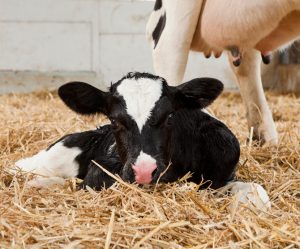
References available upon request

